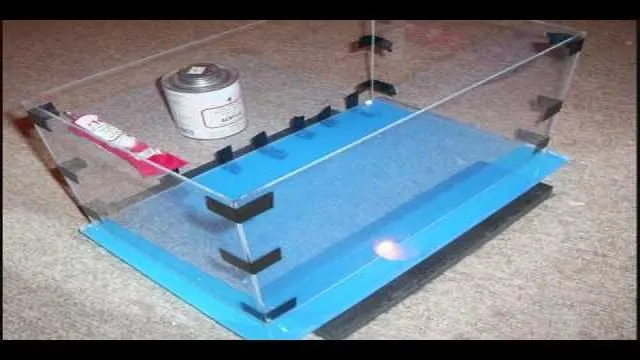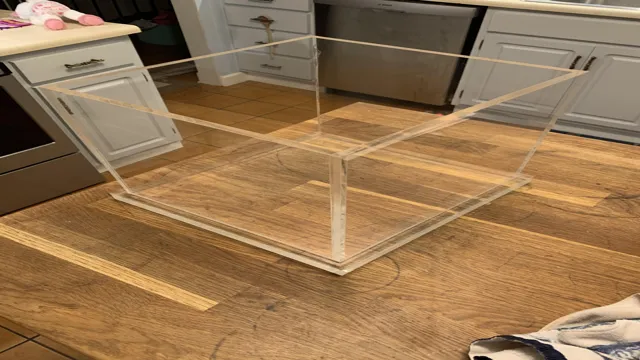Have you ever dreamed of having your own aquarium in your home or office but couldn’t find the perfect one? Maybe you weren’t satisfied with the sizes and designs available on the market or found them too expensive. Well, what if we told you that you can build your own acrylic aquarium from scratch? Sounds exciting, doesn’t it? Building your own aquarium can be a fun and rewarding project if done right. Not only can you customize it to your exact preferences, but you also get the satisfaction of knowing that you created something unique.
Plus, it can be more cost-effective than buying a pre-made one. However, before diving into this project, there are some key things you need to keep in mind. First, you need to have a clear plan and design.
This includes deciding on the size, shape, and location of your aquarium. You also need to consider the equipment and accessories you’ll need, such as filters, pumps, and lighting. Another important aspect is the material you’ll be using.
Acrylic is a popular choice for aquariums as it’s stronger and more durable than glass. It’s also easier to work with and can be bent or shaped to fit your design. However, it can scratch easily, so you’ll need to take extra care when handling and cleaning it.
With careful planning and attention to detail, building your own acrylic aquarium can be a fun and rewarding experience. It can provide years of enjoyment as you watch your fish thrive in their new underwater home. So, are you ready to dive in and create your very own aquarium masterpiece?
Introduction
Have you ever considered making your own acrylic aquarium? It may seem intimidating at first, but it’s actually a fairly straightforward process that can yield satisfying results. To begin, you’ll need to gather the necessary materials: acrylic sheets, a solvent cement, a saw, and sandpaper. You’ll also need a plan for the size and shape of your aquarium, as well as any additional features you want to include (such as dividers or lids).
Once you have all your materials and plans in place, it’s time to start cutting and assembling the acrylic sheets. This is where the saw and sandpaper come in handy, as they can help you create precise cuts and smooth edges. As you work, be sure to use the solvent cement to securely join the pieces of acrylic together.
Before you know it, you’ll have your very own custom acrylic aquarium ready to showcase your fish and aquatic plants. With a bit of patience and care, anyone can learn how to make their own acrylic aquarium and enjoy the process along the way.
Why Build Your Own Aquarium with Acrylic?
Acrylic aquariums are becoming increasingly popular among fish enthusiasts due to their durability, versatility, and clarity. Building your own acrylic aquarium offers numerous benefits such as customization, cost savings, and the satisfaction of owning something you’ve created yourself. Acrylic is a lightweight and robust material that is less prone to breakage than traditional glass tanks, making it an excellent choice for those who require a sturdy, long-lasting aquarium.
Additionally, acrylic allows for more intricate designs and shapes that would be impossible with glass. So if you’re looking to build your own aquarium, consider using acrylic for a seamless and visually stunning result.

What You Will Need to Build Your Acrylic Aquarium
Building your own acrylic aquarium can be a fun and rewarding project that allows you to create a unique and personalized aquatic habitat. However, before getting started, there are a few key items you’ll need to have on hand. Firstly, you’ll need a high-quality sheet of acrylic, which will serve as the main structural component of the tank.
It’s important to choose a thickness that can withstand the pressure of the water, while also being easy to work with. Additionally, you’ll need a bonding agent, such as solvent cement or a specialized bonding agent, to securely join the different pieces of acrylic together. Other essential supplies include a saw or cutting tool to shape the acrylic, a measuring tape or ruler to ensure accuracy, and a protective mask and gloves for safety during the cutting and bonding process.
By gathering these necessary items, you’ll be well on your way to building your own custom acrylic aquarium that will be the envy of all your aquatic-loving friends.
Designing Your Acrylic Aquarium
Making your own acrylic aquarium can be a fun and rewarding project for those who are interested in keeping fish or other aquatic animals. The first step is to determine the size and shape of the aquarium you want to create. Acrylic is a great material to use because it is strong, lightweight, and can be easily molded into different shapes.
You will need to purchase acrylic sheets, which can be found at most hardware stores or online. Once you have your materials, you can start cutting and shaping the sheets to fit your design. Be sure to smooth out the edges and use bonding agents to hold the pieces together securely.
It’s important to take your time and be patient during the construction process to ensure that your aquarium is strong and leak-proof. Once complete, you can add water, decorations, and fish to enjoy your beautiful new creation. With some creativity and effort, anyone can design their own acrylic aquarium. (See Also: How to Generate Water from an Aquarium: DIY Tips and Tricks)
Choosing the Right Acrylic Thickness
If you’re designing an acrylic aquarium, it’s important to choose the right thickness for your tank to ensure its durability and safety. The thickness of your acrylic depends on the size of your tank, the depth of the water, and the pressure it will sustain. Generally, the thicker the acrylic, the more it can withstand pressure.
For smaller tanks or ones with a lower water pressure, a thinner acrylic might be sufficient, but for larger tanks or ones with a higher pressure, a thicker acrylic would be necessary. It’s also important to consider the visual aspect of the acrylic; a thicker acrylic might be more noticeable, and a thinner acrylic might give a less distorted view of the fish. It’s important to consult with a professional to determine the right thickness for your specific aquarium needs to ensure the safety and longevity of your acrylic aquarium.
Choosing the Right Shape and Size
Designing an acrylic aquarium requires careful consideration of both the shape and size of the tank. The right shape and size will depend on a variety of factors, including the space available in your home or office, the type and number of fish or other aquatic creatures you want to keep, and your personal aesthetic preferences. Rectangular tanks are a popular choice due to their classic shape and versatility, while bowfront or hexagonal tanks can add a unique visual appeal to your space.
It’s important to choose a size that provides ample swimming space for your fish and also allows for proper filtration and maintenance. Keep in mind that a larger tank will require more equipment and may be more expensive to set up, but can also provide a healthier environment for your aquatic pets. Ultimately, the shape and size of your acrylic aquarium should reflect your personal style and meet the needs of your aquatic inhabitants.
Cutting the Acrylic Sheets
When it comes to designing an acrylic aquarium, one of the most important steps is cutting the acrylic sheets. This can be quite tricky and requires precision, as even a slight error can result in a flawed finished product. Firstly, it’s important to use the right kind of equipment for cutting acrylic.
A jigsaw or circular saw with a fine-toothed blade is ideal for this purpose. Measure the size of the sheets you need beforehand and mark them with a sharpie or pen. Take care to follow the markings precisely to ensure the sheets are cut evenly.
It’s also crucial to avoid overheating the acrylic while cutting, as this can cause it to warp or crack. In order to avoid this, make sure to use steady cutting motions and take breaks as necessary. By following these steps, you can create a beautiful and functional acrylic aquarium that will last for years to come.
Assembling Your Acrylic Aquarium
If you’re looking for a unique and customizable aquarium, making your own acrylic tank could be the perfect option. Here’s how to get started with assembling your tank. First, gather all the necessary materials, including acrylic sheets, a tape measure, silicone sealant, and a razor blade.
Next, begin by measuring and cutting the acrylic sheets to the desired size and shape for your tank. Be sure to take your time and make precise cuts, as any mistakes can compromise the tank’s integrity. Once the pieces are cut, use the silicone sealant to glue them together, making sure to create a watertight seal.
Allow the tank to dry completely before adding water and any decorations or fish. With some patience and careful attention to detail, you can enjoy a beautiful and unique acrylic aquarium that you created yourself.
Preparing the Edges
When it comes to assembling your acrylic aquarium, preparing the edges is a crucial step that can make or break the success of your project. The first thing you need to do is ensure that the edges of your aquarium pieces are completely smooth and free from any rough spots or burrs. This is important because any imperfection in the edges can cause the acrylic to crack or chip when pressure is applied to it.
To prepare the edges, you can use sandpaper or a polishing wheel to carefully smooth out any rough areas. Once the edges are prepped, you can then begin the process of bonding the pieces together using an acrylic adhesive. With careful preparation and attention to detail, you can create a beautiful, sturdy acrylic aquarium that will bring joy to you and your aquatic pets for years to come.
Assembling the Sides
Assembling an acrylic aquarium can be a fun and exciting project! One of the critical steps in the assembly process is putting together the sides of the tank. Before you begin, ensure that you have all the necessary tools and supplies, including aquarium silicone, a caulking gun, and acrylic cleaner. First, start by cleaning the edges of the acrylic panels with the cleaner to remove any dirt and debris.
Next, apply a thin bead of silicone along one edge of the panel and fit it into place with the adjoining panel. Press the two panels together firmly, making sure the edges line up correctly. Repeat the process with the two remaining sides, being careful not to leave any gaps or air pockets.
Once all the sides are in place, run a final bead of silicone along each corner to seal everything together. Give the silicone time to dry fully before filling the tank with water. With a little patience and careful attention to detail, you can create a beautiful and sturdy acrylic aquarium that you’ll enjoy for years to come! (See Also: How to Kill Detritus Worms in Aquarium: 5 Effective Methods)
Sealing the Joints
Assembling your acrylic aquarium may seem like a daunting task, but it’s actually quite manageable with the right tools and a little bit of patience. One of the most important steps in the process is sealing the joints. This ensures that your aquarium will be watertight and that your fish will have a safe and healthy environment.
To seal the joints, you’ll need aquarium silicone, which is specially designed to be safe for use with fish and plants. Start by removing any excess glue or debris from the joint areas. Apply a thin, continuous bead of silicone along the joint, making sure to cover it completely.
Use a gloved finger or a credit card to smooth out the silicone and remove any air pockets. Allow the silicone to dry according to the manufacturer’s instructions. It’s important to seal all the joints, including those between the base and the sides, and between the sides themselves.
This will ensure that the aquarium doesn’t leak and that it remains strong and sturdy. Once the silicone is dry, you can fill the aquarium with water and let it sit for a day to make sure there are no leaks. If all goes well, you can then proceed with adding your substrate, decorations, and of course, your fish.
In conclusion, sealing the joints is a crucial step when assembling your acrylic aquarium. By using aquarium silicone and thoroughly sealing all the joints, you can ensure that your fish will be safe and happy in their new home. With a little bit of care and attention, you can create a beautiful and functional aquarium that you’ll enjoy for years to come.
Adding Features to Your Acrylic Aquarium
If you’re interested in how to make your own acrylic aquarium, you might also want to consider the various features you can add to it. One important feature is filtration, which is essential for maintaining a healthy aquatic environment. There are a wide variety of filters available, including canister filters, sump systems, and hang-on-back filters.
Another feature to consider is lighting, which can be used to enhance the beauty of your aquarium while also providing the necessary spectrum of light for your aquatic plants and animals. You can choose from fluorescent, LED, and metal halide lighting options. Additionally, you might want to consider adding a heater to maintain the ideal temperature within your aquarium.
Finally, don’t forget about accessories like decorations, substrate, and background materials, which can help create a natural and inviting environment for your aquatic pets. By incorporating these features into your acrylic aquarium, you can create a thriving ecosystem that is both beautiful and functional.
Adding Filtration Systems and Pumps
Adding a filtration system and pump to your acrylic aquarium is an excellent way to keep your fish and other aquatic life healthy and thriving. Not only do they help to maintain the water’s quality, but they also keep the water circulating and oxygenated. There are a variety of filtration systems and pumps available on the market, so it’s crucial to select the right one for your setup.
Some popular choices include sponge, canister, and power filters. A good rule of thumb is to choose a system that can handle at least twice the volume of your aquarium. When installing the system, make sure that it aligns well with the tank and consider hiding it with décor if it isn’t aesthetically pleasing.
Overall, adding a filtration system and pump is an investment in your aquarium’s health and longevity.
Adding Lighting
When it comes to acrylic aquariums, adding lighting is a great way to enhance the visual appeal of your setup. Whether you’re looking to create a dazzling underwater environment or simply give your fish an extra boost of brightness, there are plenty of lighting options to consider. Some popular choices include LED strips, pendant lights, and adjustable fixtures.
Adding lighting not only highlights the beauty of your fish, corals, and plants, but can also create a more comfortable environment for them if they require specific lighting conditions. So, if you want to take your acrylic aquarium to the next level, consider adding some lighting and watch your tank come to life!
Adding Decorations and Plants
If you’re looking for a way to jazz up your acrylic aquarium, adding decorations and plants is a great way to do it. Plants can provide a natural look to your aquarium while also serving as a place for your fish to hide. Adding decorations like rocks, driftwood, and caves can create depth and variety in your aquarium’s design. (See Also: How to Kill Cyanobacteria in Freshwater Aquarium: The Ultimate Guide)
When it comes to selecting plants for your aquarium, it’s important to choose ones that are compatible with your fish and aquarium conditions. Some common choices include Java ferns, Amazon swords, and Anubias. When selecting decorations, make sure they are made for use in aquariums and won’t harm your fish or water quality.
Not only do decorations and plants add visual interest to your aquarium, but they also serve a functional purpose. They can provide shelter for your fish and places for them to explore, which can reduce stress and increase their overall well-being. By incorporating decorations and plants into your aquarium design, you can create a personalized, unique look that your fish will love.
So go ahead and get creative – the possibilities are endless!
Conclusion
Congratulations! You’ve just swam upstream like a determined salmon and created your very own acrylic aquarium! Now, sit back and enjoy the refreshing view of your personal aquatic oasis. Remember, with great power comes great responsibility, so take care of your fishy friends and keep in mind that you’re now part of a larger underwater community. As Aquaman would say, “you don’t need powers to be a hero, you just need to be brave enough to do the right thing.
” And building an acrylic aquarium is certainly a brave and admirable endeavor. So, grab your trident (or power drill) and dive in!
FAQs
What materials do I need to make my own acrylic aquarium?
To make your own acrylic aquarium, you will need acrylic sheets, a saw, solvent cement, an aquarium safe silicone sealant, a ruler, and a level.
Can I use glass instead of acrylic for my aquarium?
While glass is a common material for aquariums, acrylic is a more durable and lightweight option, making it ideal for larger aquariums. However, if you prefer glass for aesthetic reasons, it can still be used for smaller aquariums.
What size should my acrylic aquarium be?
The size of your aquarium will depend on the type of fish or aquatic creatures you plan to house. A general rule of thumb is to have 1 gallon of water per inch of fish. Make sure to also consider the size and weight of the aquarium, as well as the space you have available.
How do I cut the acrylic sheets for my aquarium?
You can cut acrylic sheets using a saw with a fine-toothed blade. It is recommended to use a circular saw or a table saw for straight cuts, and a jigsaw or coping saw for curved cuts.
How do I assemble the acrylic sheets for my aquarium?
To assemble the acrylic sheets for your aquarium, you will need to use solvent cement to create a strong bond. Apply the cement to the edges of the acrylic and press them together firmly. Use clamps or weights to hold the pieces in place while the cement dries.
How do I seal my acrylic aquarium?
To seal your acrylic aquarium, use an aquarium safe silicone sealant around the edges of the acrylic sheets. Make sure to apply the sealant evenly and let it dry completely before filling the aquarium with water.
How do I maintain my acrylic aquarium?
To maintain your acrylic aquarium, regularly check the water quality, temperature, and pH levels. Perform partial water changes and clean the aquarium walls and decorations to prevent algae growth. Avoid using harsh chemicals or abrasive materials on the acrylic.







